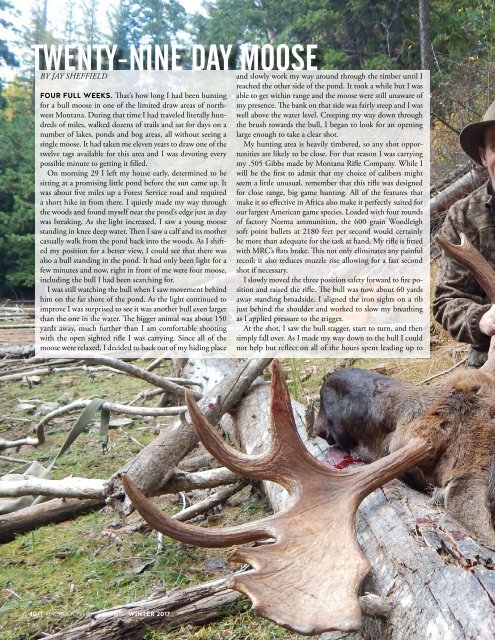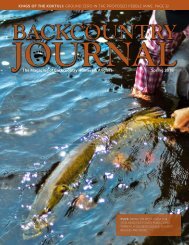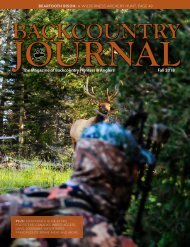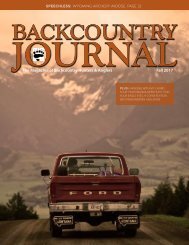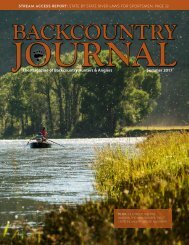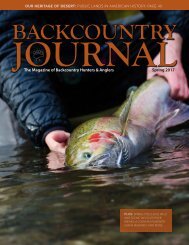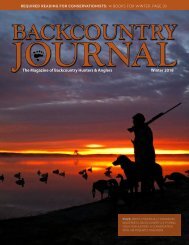BCJ_WINTER17 Digital Edition
You also want an ePaper? Increase the reach of your titles
YUMPU automatically turns print PDFs into web optimized ePapers that Google loves.
TWENTY-NINE DAY MOOSE<br />
BY JAY SHEFFIELD<br />
FOUR FULL WEEKS. That’s how long I had been hunting<br />
for a bull moose in one of the limited draw areas of northwest<br />
Montana. During that time I had traveled literally hundreds<br />
of miles, walked dozens of trails and sat for days on a<br />
number of lakes, ponds and bog areas, all without seeing a<br />
single moose. It had taken me eleven years to draw one of the<br />
twelve tags available for this area and I was devoting every<br />
possible minute to getting it filled.<br />
On morning 29 I left my house early, determined to be<br />
sitting at a promising little pond before the sun came up. It<br />
was about five miles up a Forest Service road and required<br />
a short hike in from there. I quietly made my way through<br />
the woods and found myself near the pond’s edge just as day<br />
was breaking. As the light increased, I saw a young moose<br />
standing in knee deep water. Then I saw a calf and its mother<br />
casually walk from the pond back into the woods. As I shifted<br />
my position for a better view, I could see that there was<br />
also a bull standing in the pond. It had only been light for a<br />
few minutes and now, right in front of me were four moose,<br />
including the bull I had been searching for.<br />
I was still watching the bull when I saw movement behind<br />
him on the far shore of the pond. As the light continued to<br />
improve I was surprised to see it was another bull even larger<br />
than the one in the water. The bigger animal was about 150<br />
yards away, much further than I am comfortable shooting<br />
with the open sighted rifle I was carrying. Since all of the<br />
moose were relaxed, I decided to back out of my hiding place<br />
and slowly work my way around through the timber until I<br />
reached the other side of the pond. It took a while but I was<br />
able to get within range and the moose were still unaware of<br />
my presence. The bank on that side was fairly steep and I was<br />
well above the water level. Creeping my way down through<br />
the brush towards the bull, I began to look for an opening<br />
large enough to take a clear shot.<br />
My hunting area is heavily timbered, so any shot opportunities<br />
are likely to be close. For that reason I was carrying<br />
my .505 Gibbs made by Montana Rifle Company. While I<br />
will be the first to admit that my choice of calibers might<br />
seem a little unusual, remember that this rifle was designed<br />
for close range, big game hunting. All of the features that<br />
make it so effective in Africa also make it perfectly suited for<br />
our largest American game species. Loaded with four rounds<br />
of factory Norma ammunition, the 600 grain Woodleigh<br />
soft point bullets at 2180 feet per second would certainly<br />
be more than adequate for the task at hand. My rifle is fitted<br />
with MRC’s flats brake. This not only eliminates any painful<br />
recoil; it also reduces muzzle rise allowing for a fast second<br />
shot if necessary.<br />
I slowly moved the three position safety forward to fire position<br />
and raised the rifle. The bull was now about 60 yards<br />
away standing broadside. I aligned the iron sights on a rib<br />
just behind the shoulder and worked to slow my breathing<br />
as I applied pressure to the trigger.<br />
At the shot, I saw the bull stagger, start to turn, and then<br />
simply fall over. As I made my way down to the bull I could<br />
not help but reflect on all of the hours spent leading up to<br />
this moment. If you have never had the opportunity to approach<br />
a downed moose, I can assure you that there is no<br />
such thing as “ground shrinkage.” With every step you take,<br />
they just get bigger and bigger.<br />
Sitting there alone with such a massive animal is a very<br />
humbling experience, and it’s one that I took a long moment<br />
to savor. I ran my hand across the coarse fur on its body; I<br />
touched the rock hard antler and then struggled to lift its<br />
head. It is almost surreal how truly massive these animals are.<br />
I tagged the moose and then took a few photos. By this time<br />
the adrenaline from all of the excitement was starting to fade<br />
and the reality of the enormous task ahead was starting to<br />
sink in. I hiked out of the basin and made some calls to assemble<br />
a team that could help me process the moose. In just<br />
a few hours I had a group of five enthusiastic friends helping<br />
with skinning, butchering and packing. By 1:30 in the afternoon<br />
the last load was packed out and nothing but the rib<br />
cage, spine and entrails remained at the site – something that<br />
the scavengers will certainly enjoy cleaning up.<br />
The ride back to town was a quiet one; I was both tired<br />
and sore but could not have been any happier. I dropped the<br />
meat off for processing then took the head and hide to my<br />
taxidermist. At every stop I shared the pictures and story of<br />
my moose hunting adventure. I cannot apply for another<br />
Montana moose tag until 2023, but it’s a safe bet that my application<br />
will be in the mail on the first day I am eligible!<br />
Jay is a BHA member and hunter education intructor living<br />
in the woods of northwest Montana. He serves on the Montana<br />
Fish, Wildlife & Parks Citizens Advisory Council.<br />
40 40 | | BACKCOUNTRY JOURNAL WINTER FALL 2016 2017 WINTER 2017 2017 BACKCOUNTRY JOURNAL | | 41 41


